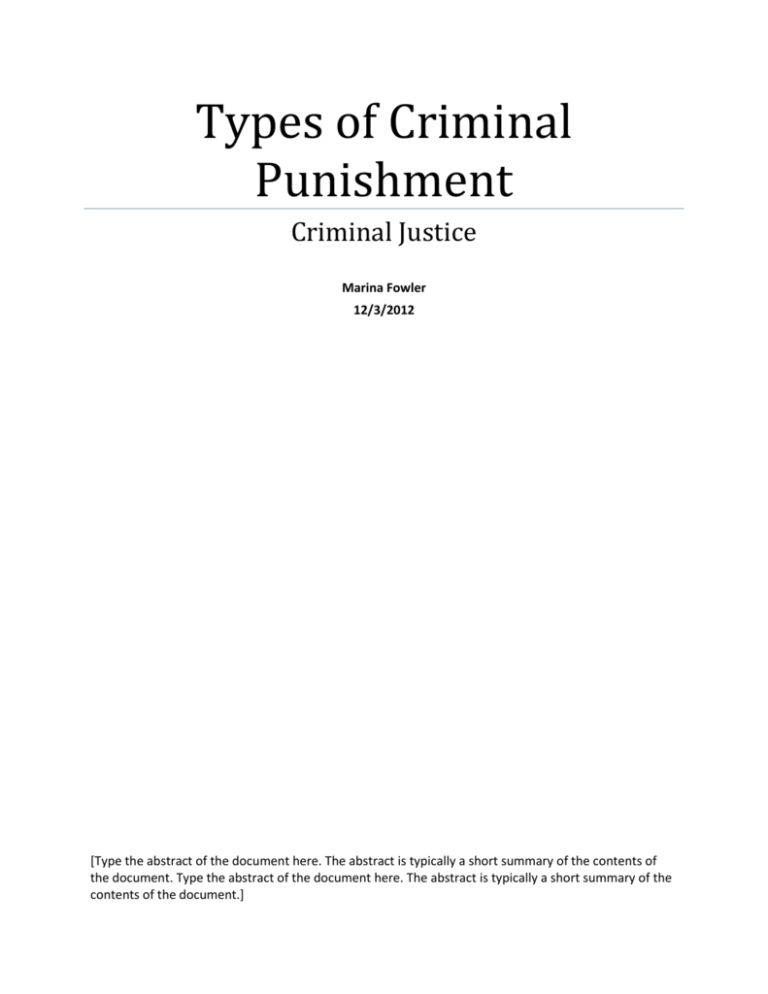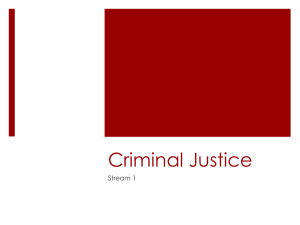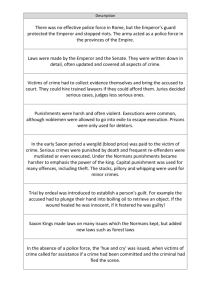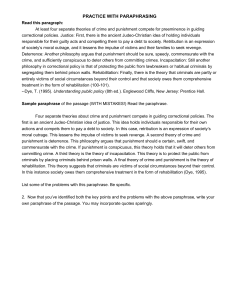Types of Criminal Punishment
advertisement

Types of Criminal Punishment Criminal Justice Marina Fowler 12/3/2012 [Type the abstract of the document here. The abstract is typically a short summary of the contents of the document. Type the abstract of the document here. The abstract is typically a short summary of the contents of the document.] There are several theories of justice used to punish criminal behavior in society today. Three of the most prominent forms are retributive justice, retribution/restorative justice and reformative justice. Retributive justice, the one used most by the United States, is the form of justice based on the ancient belief that punishment is the only true way to obtain justice and prevent crime. Retribution-based and restorative justice focus on the idea of putting the victim and society back to where they were before the crime was committed. Reformative justice is an alternative approach to justice that tries to prevent and move past crime by way of understanding the motivation for the crime and repairing and rehabilitating criminal offenders. So, which way is better? Which type of justice is actually the most effective? Studies and rising crime rates have shown the retributive approach to justice isn’t proving to be as effective as once thought and is not progressive in approach. Retributive justice is a form a justice based on the ancient Jewish law “Lex Talinonis;” it is the law of measure-for-measure, an eye-for-aneye, or leg-for-a-leg. Under the paradigm of retributive justice, he who commits a crime should be punished in a manner equal to or worse than the crime they committed. It revolves around the idea of what punishment society believes is deserved by the person who committed the crime and how the community can make the person pay for it, the “let the punishment fit the crime” paradigm. This type of justice is focused on inflicting punishment, with no other factors needing consideration. Types of retributive punishment often lead to imprisonment, loss of property, and even loss of life in an effort to see that someone who commits a crime is punished in a way that is proportionate to the crime that has been committed. Retribution as a form of justice has been used by many civilizations throughout the course of history due to the strong connection between governmental imposed order and the religious underpinnings of a given society. Unfortunately, like many ancient religious concepts, the way in which 1 governments maintained control and order in a community under this paradigm was by using fear and guilt over causing greater harm to the community as the motivators. Stemming from the idea of the “divine retribution,” retributive justice gained widespread acceptance in large part because of the idea that government a conduit for the alternative, supernatural punishment of a person. It was thought that many calamities endured by a community were inflicted by a deity in response to unacceptable human action. The community was thus compelled to intervene and punish those responsible in an attempt to avoid the considerably more grave consequences of punishment imposed by an angry god. As can be seen in so many ancient civilizations, sometimes the only way to maintain order and obtain justice, was by way of using punishments so severe that they would create enough fear in a potential offender that he or she might suffering the same punishment, that it kept the potential offender in line; whether through a deity or by the community. One reasoning for this type of punishment was the concept of equality and the preservation of society as whole. Meaning that people should all be treated equally whether crime is a factor or not. And when someone breaks that equality by committing a crime against someone else, then punishment will and can be the only way to maintain any sort of social balance. The belief is that, you will get what you give and get taken away what you take. The approach that retribution takes against crime today, is essentially the same; if you hit someone’s hand hard enough when they are trying to take something of yours, they will stop what they are doing and have no desire to do it again. The consequences of their actions would just not be worth it. Now, with the focus of retribution being based on the laws instituted by society rather than supernatural forces, it is believed that if criminal offender is punished harshly enough they will either learn their lesson and never disrupt the peace again, or they’ll be put in jail and therefore not have the ability to disrupt the peace or endanger society. But this begs the question of whether harsh punishments are morally right in light of an individual’s basic human rights. 2 The principle of willful wrongdoing states that society is morally justified in punishing someone if that person was aware that he or she committed the crime, yet committed the crime anyway. The 19th century philosopher, Immanuel Kent, argued in favor of retribution, stating “the only legitimate form of punishment the court can prescribe must be based on retribution and no other principle.” He further stated that “Judicial punishment can never be used merely as a means to promote some other good for the criminal himself or for civil society, but instead it must in all cases be imposed on him only on the ground that he has committed a crime.” Kant clearly saw punishment as a matter of justice, and believed it mandatory that justice be carried out by the state for the sake of giving teeth to the rule of law and not for the sake of the criminal or the victim. He argues that “if the guilty are not punished, justice is not done. Further, if justice is not done, then the idea of law itself is undermined.” In exploring and understanding various schools of thought on crime and punishment, we must also consider some of the alternative forms of justice available in the criminal justice system. Restitution-based justice and restorative justice are two, closely related, such alternatives. Restitution, as noted in our criminal justice text book, is the “[m]onetary compensation for damages done to the victim by the offenders’ criminal act.” Restorative justice is a relatively new method of criminal justice in which the focus of criminal punishment is predominantly on the victim and repairing the harm done to the victim or community, by an offender’s criminal act. Restorative justice is a growing social awareness that tries to promote a more peaceful approach to dealing with the harms committed by an offender to “restore” peace and order to society. According to Zehr and Mika (1998), there are three key ideas that support restorative justice: “First is the understanding that the victim and the surrounding community have both been affected by the action of the offender and, in addition, restoration is necessary. Second, the offender's obligation is to make amends with both the victim and the involved community. Third, and the most important process of restorative justice, is the concept of 'healing,' or the collaborative unburdening of pain for the victim, offender, and community.” 3 Both restitution based justice and restorative justice look to the victim first in determining punishment, however restorative justice takes that idea one step further and looks to set the offender right as well. With its emphases on healing the community, protecting human rights – even those of the offender – and using compassion in sentencing, restorative justice is being adopted and integrated in a variety of different settings as an alternative form of attaining justice. It is used by groups ranging from international peacemaking tribunals such as the South Africa Truth and Reconciliation Commission, to innovations within the criminal and juvenile justice systems here in the United States, as well as in schools, social services organizations and local communities. Restorative justice is founded in the belief that by giving the offender a chance to try and make right what he has wronged, by apologizing to the victim, giving financial reparations to the victim and participating in community treatment programs, both the offender and the victim will be able to reestablish themselves as productive and progressive members of society. The aim of restorative justice is to restore the balance between two parties that have been imbalanced due to the acts of one against the other. Researcher and author on criminal justice issues, L. Zedner, argues “restorative justice simultaneously restores the harm done to victims, reintegrates the offender into civil society, restores and rebuilds the community and aids in reducing crime.” As said by Axel Liebmann “a way of seeing restorative justice is to think of it as a balance among a number of different tensions: a balance between the therapeutic and the retributive models of justice, a balance between the rights of offenders and the needs of victims, and a balance between the need to rehabilitate offenders and the duty to protect the public.” The last approach to criminal justice is that of Rehabilitative justice. Rehabilitative justice is arguably the most “humane” in its treatment of the offender and effective in its deterrence of crime and criminal activity, since it seeks to reform the offender. As noted in our criminal justice text book, 4 “rehabilitation is the philosophy that society is best served when wrongdoers are provided the resources needed to eliminate criminality from their behavior pattern.” Rehabilitation means “to restore to useful life, as through therapy and education or to restore to good condition, operation, or capacity.” As crime and incarceration rates within the United States are at all-time highs, it is evident that the type of justice currently used, largely retributive justice, has not been effective. After exploring the various types of criminal punishment, the question remains, which of these methods is most effective? Which type of criminal punishment is actually effective in preventing crime and preserving the safety of our community? As supported by a variety of studies and analysis of the current state of criminal justice, the most effective possible approach to punishment in today’s world is rehabilitative justice. The way in which rehabilitative justice attempts to both prevent crime and reform the criminal is through its focus the idea that crime is a “social phenomenon” that is caused by a certain set of circumstances or environments. It does not believe the idea that some people are just bad by nature and the “pound of flesh” is the only way to deter crime. The belief is that, by stripping a criminal down to their core, by removing all of the factors that could have contributed to their criminal activity as well as giving them the right tools to reshape who they are as individuals, we will be able to both address punishment for the crimes committed as well as prevent crimes from happening in the future. The purpose of rehabilitation is to not punish the desire to harm out of the criminal, which has not proven effective, but rather, to provide them with types of education, therapy and skills that will help “reform” them into becoming a productive member of society. Rehabilitative justice, unlike the most commonly used, punitive-based retributive justice, focuses on fixing the problem of crime from the inside out, instead of using punishment as the only way to obtain justice. It is a theory which believes in the humanity of people, rather than automatically condemning them for having run afoul of society’s laws. Rehabilitative justice focuses not only moving 5 forward past the crime committed but also in helping the criminal who committed the crime move forward by giving them the appropriate tools. These tools, it is believed, will assure that when the offender is released back into society, they will have redefined themselves and no longer feel inclined to commit crimes. In 2008, the Pew Center on the States reported that incarceration levels had risen to a point where one in 100 American adults were behind bars. A second Pew study the following year added another disturbing dimension to the picture, revealing that one in 31 adults in the United States was either incarcerated or on probation or parole. [If this is a quote it needs to be in quotations] Additionally, the New York Times has reported “while the US only has 5% of the world’s population, it has approximately 25% of the world’s prisoners.” Unfortunately these studies reveal a very devastating truth about our criminal justice system that the most widely accepted form of justice, retributive justice, is not working. In an article analyzing rehabilitation versus punishment, the author argues “sentencing offenders to incarceration hurts the family structure by contributing to single parenting.” The author also argues that incarceration as punishment causes social disorientation, alienation, and also increases the risk of recidivism. When an offender is released from incarceration they face social isolation, stigmatism, economic and employment challenges. Rehabilitation through community supervision eliminates many of these issues, not the least of which are the economic and employment factor, since the offender is often required to work as a condition of his or her release. Such probation allows offenders to remain with their families and continue working the under the close supervision of a probation officer. Although punishment is necessary for the offender, there exist better and more effective ways of punishing an offender that will actually make a difference not just with the offender himself but with society as well. This theory of punishment is based on the notion that “punishment is to 6 be inflicted on an offender so as to reform him/her, or rehabilitate them so as to make their reintegration into society easier. Punishments that are in accordance with this theory are community service, probation orders, and any form of punishment which entails any form of guidance and aftercare towards the offender.” Of the three main theories of criminal punishment, reformative justice is the approach most likely to result in lowered crime rates and lowered rates of recidivism among offenders. It is simply the only solution capable of actually changing an offender’s behavior in the long term. Retributive justice only focuses on a black and white view of law and justice – you commit a crime, you do the time. It does nothing to help fix the problem behavior and the offender is left to maintain his offending ways. Retributive justice is an outdated, backward approach to crime and punishment and does nothing but overflow our jails. There is no humanity in the idea that two wrongs make a right. Further, although the purpose is ostensibly to obtain justice, restitution-based justice only compensates the victim or society but like retribution-based justice, does nothing to change the behavior of the offender, who is left once again to continue committing crimes. Clearly, our society cannot afford to incarcerate more people. In order to move people out of jails and start them on the path to becoming productive members of society, we must move toward instituting punishment based on a reformative justice model. 7 (Milwaukee and Outagamie Counties, June 2004) http://legis.wisconsin.gov/lab/reports/04-6highlights.htm //entrylvl.wordpress.com/2011/08/10/prison-punishment-and-recidivism-an-argumentagainst-retributive-justice/ (Retributive justice vs. Restorative justice, Dec 26, 2011) http://dustydsreflections.blogspot.com/2011/12/retributive-justice-vs-restorative.html Aitken, J., The way we treat prisoners creates a conveyor belt of crime. The Independent, 23 March 2009, http://www.independent.co.uk/opinion/commentators/jonathan-aitken-the-wa... Bois, N. D. Retribution and Rehabilitation: A Modern Conservative Justice Policy. Dale & Co. 20 July 2011 http://www.iaindale.com/posts/retribution-and-rehabilitation-a-modern-conservative-justicepolicy Bowcott, Owen, Haroon Siddique and Andrew Sparrow, ‘Facebook cases trigger criticism of ‘disproportionate’ riot sentences’, guardian.co.uk, 17 August 2011, http://www.guardian.co.uk/uk/2011/aug/17/facebook-cases-criticism-riot-s... Byrne, R., & McCutcheon, P. Byrne and McCutcheon on the Irish Legal System. Bloomsbury Professional, London, 2009. Chang, K. O. Lock up repeat offenders for life. Jamaica Gleaner, 17 September 2006, http://jamaica-gleaner.com/gleaner/20060917/focus/focus2.html 8 Directgov. Rehabilitation versus punishment - judge for yourself. 1 July 2008, http://www.direct.gov.uk/en/Nl1/Newsroom/DG_170371 Directgov, ‘Education, training and working in prison’, http://www.direct.gov.uk/en/CrimeJusticeAndTheLaw/Sentencingprisonandprobation/Goingtoprison/D G_196222 Dodd, Vikram, ‘Police face years of public disorder, former Met chief warns’, guardian.co.uk, 6 December 2011, http://www.guardian.co.uk/uk/2011/dec/06/police-years-public-disorder-wa... Doyle, J., ‘£140,000: the annual cost of jailing a young criminal’. The Guardian, 1 March 2010, http://www.guardian.co.uk/society/2010/mar/01/jail-young-offenders-rehab... Evans, J., Deterrence, Retribution and Rehabilitation. Athenaeum Library of Philosophy: http://evans-experientialism.freewebspace.com/evans_retribution.htm Jingqiong, Wang and Zhu Zhe, ‘Former richest man gets 14 years in prison’, China Daily, 19 May 2010, http://www.chinadaily.com.cn/china/2010-05/19/content_9865282.htm Landry, P. On The Theory of Punishment. Blupete, 2011, http://www.blupete.com/Literature/Essays/BluePete/PunishmentTheory.htm 9 Law Library. Theories of Punishment. Law Library: http://law.jrank.org/pages/17017/Punishment-Theories.html Malik, Shiv, ‘UK riots cause 8% rise in jailed children’, guardian.co.uk, 8 September 2011, http://www.guardian.co.uk/society/2011/sep/08/uk-riots-rise-in-jailedchildren?INTCMP=ILCNETTXT3487 Pew Center on the States, State of Recidivism. The Pew Charitable Trusts, Washington, DC, 2011 Raynor, P., & Robison, G. Rehabilitation, Crime and Justice. Palgrave Macmillan, 2005 Stanford, P. (2007, August 23). The road to redemption: Does the rehabilitation of prisoners work? The Independent, 23 August 2007, http://www.independent.co.uk/news/uk/crime/the-road-toredemption-does-t... Women in Prison. Statistics. Women in Prison: http://www.womeninprison.org.uk/statistics.php http://idebate.org/debatabase/debates/law-crime/house-believes-criminal-justice-shouldfocus-more-rehabilitation (CDCR news blog, New Recidivism Report Shows Decline of Inmates Returning to Prison, Nov 2 2010) http://cdcrtoday.blogspot.com/2010/11/new-recidivism-report-shows-decline-of.html 10 (Restitution reduces recividism, Crime and justice newsletter, October 1990-March 1991) http://www.colorado.edu/conflict/crcii/Rjus-14.pdf (Punishment vs Rehabilitation in the Criminal Justice SystemNov 28, 2006,A K Larrabee,) http://voices.yahoo.com/punishment-vs-rehabilitation-criminal-justice-119962.html?cat=17 (August 12, 2012- Punishment- psychology definition of the week, Kendra Cherry)http://psychology.about.com/b/2011/08/12/punishment-psychology-definition-of-theweek.htm (Stanford Encyclopedia of Philosophy Jun 13, 2003; substantive revision Fri Feb 19, 2010) http://plato.stanford.edu/entries/p http://suite101.com/article/the-philosophies-ofpunishment-a199184unishment/#2 The Classical School of Criminology has proposed that punishment is used to create deterrence and the Positive School of Criminology uses the practice of rehabilitation to reduce recidivism. 11








